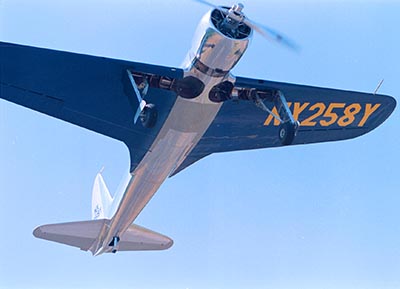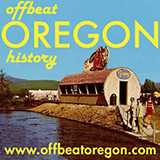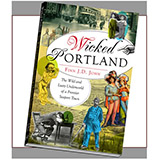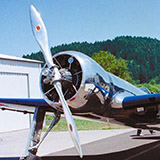MAGAZINE ARTICLE
The heroic final flight of Cottage Grove's Jim Wright
He'd spent thousands of hours re-creating history's most mysterious aircraft. Something had gone wrong, and he was about to crash it. When he did, somebody would die — who that would be was up to him.

Jim Wright flies a low pass over the airfield at what was then known
as the Cottage Grove State Airport, in 2002. Since then, the airport has
been renamed Jim Wright Field.
By FINN J.D. JOHN
March 2009
Jim Wright was just trying to get over the Rockies and make it home. To get him there, he was depending on a machine that looked as if it belonged in an aviation museum — and, in fact, the only other one like it was in the Smithsonian, and hadn’t flown since 1937.
That other one had been built by Howard Hughes in 1934 to set a new world speed record — which he did the following year. It was then tucked away in a dusty hangar, where it remained for the rest of Hughes' life.
Wright built the other one in 2002. Now, a little over a year later, it was a beautiful, clear day and he was soaring over the Rocky Mountains in it.
Wright was flying back home to Cottage Grove, Ore., from the legendary annual air show at Oshkosh, Wis. There, as everywhere else he’d brought his airplane, it had been the toast of the event, a perfect replica of one of the most important planes in history, with a one-digit serial number — 2. Airplane enthusiasts and history buffs alike had found the replica to be like a time machine. Everything on it, they'd noted, was either custom-made or a restored original component from the early 1930s: The enormous round engine, the cockpit controls, even the twin-blade Hamilton Standard constant-speed propeller hub that was modified in exactly the same way Hughes’ had been to complement the plane’s 1,000-horsepower engine.
It was that insistence on authenticity that would, that day, destroy his priceless aircraft and make a widow of Betty, his wife.
The dream takes form

The Hughes H-1 Racer replica, parked on the tarmac outside Jim Wright's
hangar. To the left of the picture is Wright's street-legal Formula race
car.
I first met Jim Wright in 2002, when he was putting the finishing touches on the plane — the H-1 Racer. At the time, I was the editor of his hometown newspaper, the weekly Cottage Grove Sentinel. A tiny town at the very southern tip of the Willamette Valley with farmland to the north and timberlands to the south, Cottage Grove has a correspondingly small newspaper. There were three of us — me, reporter Matthew Treder and photographer Jared Paben. Technically it was Treder’s story, but naturally we were all very interested — a major nationwide sensation was brewing up right in our own back yard.
And it was no exaggeration to call the H-1 that. It was an astonishing piece of industrial art, a shining silver tube of polished aluminum with electric-blue wings sitting on tall, spindly landing gear, the cockpit pushed way back toward the tail. Sitting there on the tarmac, with that massive, blunt engine thrust up into the air, it had an austere, uninviting, all-business look, like an unmanned missile with a propeller on the front. In the air, though, with the landing gear up and the fuselage level, it looked like a different airplane, in the spirit of the very finest industrial sculpture of the art-deco 1930s -- sleek, streamlined, fabulous.
Yet it was not designed with looks in mind. The H-1’s beauty was strictly incidental to its real purpose. The long, liquid lines in gleaming polished aluminum weren’t there to be admired; they were there to slip the air past faster so that an extra two miles per hour could be squeezed from it. The engine was round because that was the shape of the most powerful engine available at the time. The wing lines flowed out of the fuselage not for looks, but so that the wings could carry the structural load, saving a few dozen pounds. Just sitting there on the ground, pointing skyward at a 30-degree angle, it was an irrefutable demonstration that beauty and function live in the same place and may even be married to each other.
Wright himself was as quiet and unassuming as his airplane was striking and noticeable. A self-taught engineer who’d never bothered to go to college, Wright was mechanically a natural, having started out working on lawnmowers at a very young age.
“He was a real smart, real affable guy,” Treder remembered later. “Generous with his time.” Treder, who interviewed Wright several times for stories, called the aviator a “natural-born storyteller.”
He was half of the husband-and-wife team that started Wright Machine Tools in 1976. During the 25 years that followed, they built it into a lucrative business that still exists today, producing machines that sharpen and maintain industrial carbide saws, among other things. By the late 1990s it had become the kind of business that quietly overshadows the place in which it’s located. It may have occupied an unassuming beige building on the outskirts of a tiny Oregon town, but it was a multi-million-dollar enterprise.
Throughout the time from the founding of the company to the building of the H-1, Wright himself didn’t change much. Most of the time, his face wore one of two expressions: A huge, open grin or a focused look of intense concentration. Though he liked himself just fine and loved exotic toys, he showed no signs of the kind of egoism one expects from someone that successful. His office was modest, a bit cramped, dusty, stocked largely with cheap-but-serviceable furniture made of particle board covered with vinyl printed to look like oak. The computers there were originally beige, but had turned yellow with age. Wright’s desk faced the wall, making his office look like a workstation, rather than a command center.
And through a window on that wall, Wright could look out at the airport and watch planes come and go. It was no coincidence that his business was located right next to the little community airport. Wright’s father was an aviator, and passed the “bug” on to his boy; Wright bought his first plane, a Taylorcraft that he still owned, when he was just 21 years old.
As his business grew, Wright started acquiring more fast, exotic things: a rare Honda CBX six-cylinder motorcycle from the early 1980s, a red Corvette that he used for his regular driving, even a street-legal Formula race car that he drove around on special occasions -- a gift from Betty.
On the airfield outside the shop was parked an early-1950s Beechcraft Bonanza, one of those V-tailed hot rods of the sky like the one Ritchie Valens and Buddy Holly went down in. In his hangar he kept a Glassair III, a sleek kit-built plane that flew two and a half times faster than an entry-level Cessna.
But the Hughes racer: That was to be the highlight, the crown jewel in his hangar.
He’d dreamed of building the plane since 1978, when he read about it in a magazine article from the 1930s. And he’d been fascinated by the Hughes plane since he was young – its blinding speed, its secretive inventor who hurried to hide it from the world after breaking his second record with it in 1937, the persistent rumors — given extra weight by Hughes himself — that its design had been sold or leaked to Japan and had inspired the dreaded Type Zero fighter from World War II.
By the late 1990s, Wright’s business was successful enough that he was able to pursue that dream.
Building his dream
Howard Hughes is still best remembered today as a reclusive and aged billionaire with severe mental issues. Although that description hardly fit Jim Wright, the Cottage Grove entrepreneur shared several positive traits with the long-dead aviation pioneer. He had the same lean, lanky build, the same passion for things well-built and fast, and flying skills that — well, let’s face facts, Hughes was one of the best flyers of all time. But Wright was no slouch either.
Wright also shared Hughes’ ability to get the best out of the people who worked for him. This probably had something to do with Wright’s attitude. This was quite a bit different from the “I’m better than you” hit one usually gets from CEOs. His attitude was more like, “I love people, including myself — and you too.” You could see that attitude in his office layout, in his casual style of dress (he greatly favored long-sleeve plaid Western shirts and Panama hats) and in the morale of the people he led.
But the most important thing Wright shared with Hughes was ownership of a machine-and-tool company.
That meant anything Wright needed, he could simply machine for himself — just as Hughes had done.
Now he focused these critical assets on replicating Hughes’ airplane.
The original had been tucked away in an obscure hangar at Hughes Aircraft immediately after it broke its last record – the transcontinental record – in 1937, and had been out of the public’s sight until 1975, on the eve of Hughes’ death, when it was donated to the Smithsonian Institution.
Blueprints? Plans? All long gone. But Smithsonian officials Robert van der Linden and Bill Reese were willing to let Wright’s team come to Washington, D.C., and examine the original to reverse-engineer a new set of plans. The were even allowed to disassemble parts of the plane to get better measurements — a huge demonstration of trust, as the H-1 is one of the Smithsonian’s crown jewels.
“The director of the Smithsonian told me that if he could have one plane in the Smithsonian, it wouldn’t be the Wright (Brothers) Flyer,” Wright once told a reporter from the Gillette (Wyo.) News-Record. “It would be the Hughes Racer.”
Wright assembled a team of experts to help build it. Two of his employees, Guy Ralstin and Dennis Parker, worked on computer-aided design drafting so that parts could be machined by digitally-controlled machining mills. He rounded out the team with experienced aircraft builders and flyers Mike Mann, Dave Payne and Al Sherman, and hired Ron Englund to direct the team.
For a few special tasks, experts had to be hired. A man from Arkansas with legendary skills as a panel-beater spent a full year using a ball-peen hammer to beat sheets of aluminum into the highly complicated shape required for the engine cowl. Another old-style craftsman from California carved part of the wooden tail section. A local craftsman, Steve Wolf from Creswell, spent 3,000 hours building just the wings.
For the propeller, Wright’s team found a vintage Hamilton Standard hub and fitted it with blades from an Italian military plane. Just like Hughes before them, they would have trouble with that propeller.
In addition to the subcontracted parts, the team poured 35,000 man-hours into the project – the equivalent of 17 years. Total cost? Just shy of $2 million – but, of course, if Wright hadn’t owned a machine shop, it would have been much more than that.
Ready to Fly
By the spring of 2002, the plane was finally nearly ready, and Wright was starting to think about getting it into the air.
Finally, in mid-June, surrounded by a small group of admiring aviators and the entire newsroom staff of the Cottage Grove Sentinel, the plane was rolled out onto the airfield and, with that smoky belch characteristic of all radial engines, the monstrous power plant started up. Cottage Grove’s airport echoed for the first time with the rough, belligerent roar of the Hughes H-1’s massive engine.
It was the beginning of several months of continuous testing and development. Low-speed taxi testing, medium-speed taxi testing, brake checks …. Neighboring residents and businesses started getting used to the racket. After the first medium-speed taxi run, reporter Treder found Wright looking distinctly rattled.
“The airplane is intimidating. It is incredibly powerful,” he said. “I’ve never had my hand on the throttle of anything that had quite so much power. … The Hughes feels scarily powerful. In your mind, you can visualize things going wrong.”
Wright said he’d fed the engine a bunch of throttle to test the brakes, and the massive torque had tilted the whole plane, squashing down the landing-gear struts.
He turned to veteran test pilot and air racer Jimmy Leeward, of Leeward Air Ranch in Florida, for some help handling his high-powered plane. Leeward flew one of his P-51 Mustangs to Cottage Grove to help. Leeward used the Mustang to fly after Wright’s plane and observe how it was flying, helping iron out minor issues in preparation for the H-1’s first flight beyond Cottage Grove.
“Overall, there have been very minor problems, and those that have cropped up have been normal teeth-cutting items that happen to any newly constructed plane with only 15 hours of flight time,” Leeward wrote in an update letter to All Aviation Flightline Online, an enthusiasts’ website.
Leeward didn’t mention what those issues were, but at the local paper, we did – the tailwheel melted, causing a little repairable damage to the tail.
Another thing Leeward didn’t mention was Wright’s nagging worry that something bigger than a “minor problem” might be lurking. And indeed, though he kept his positive attitude up at all times, Wright had some reason to suspect there might be a problem with the plane. Hughes’ life’s biggest passion, in his younger days, was airplanes. He had built the fastest, best, most exciting airplane in the world. Why didn’t he use it? Why did it end up tucked away in an obscure hangar at Hughes Aircraft and forgotten about? It made no sense. It was like Mario Andretti having Ferrari custom-build a car for him and then never driving it.
“There was always the nagging fear that the reason Howard flew (the H-1) only 42 hours was because there was some serious problem, which he never would have said anything about,” Wright told Air & Space Magazine. “Was there a bear trap waiting for us?”
If that bear trap were to spring, Wright did not want the local newspaper to be there to witness it. Or anybody else, for that matter.
Perhaps that’s why, a few days later as I sat nursing a cup of coffee early one morning and reading the Eugene Register-Guard, I heard the distinctive sound of the plane flying over my house – sounding like a gang of Hells Angels doing subcontractor work for Santa Claus, only it was July. Wright had left the airfield early that morning for the plane’s maiden voyage, headed 70 miles north to Corvallis. No one had told us, so our photographer, Jared Paben, wasn’t there.
Of course, reporter Treder hastened to get an after-the-fact article ready for the next week’s paper. In it, Wright painted a glowing picture of the plane’s handling on the flight: “What a hoot! It handles so good. It flies just incredible,” he told Treder. “It was going 190 miles per hour at 30 percent power — you know it’s just going to scoot!”
To scoot, that is, after the propeller problems were ironed out. Mindful of the publicity, Wright didn’t tell Treder everything about the flight, but he did tell the Air & Space Magazine reporter about it. It seemed Wright was getting that 30 percent power at 100 percent of the engine’s allowable speed, because the prop wasn’t taking big enough “bites” of air. As a result, the engine was running uncomfortably hot, and Wright at one point was looking for places to make an emergency landing. Luckily, the temperature stabilized and he made it to Corvallis.
After the champagne celebration was over, Wright got back to work. To let the propeller function as it was supposed to with such a powerful engine, it needed bigger counterweights — one on each propeller blade. Without them, the centrifugal force of the propeller would make the blades take smaller bites of air.
Wright put bigger counterweights on the plane, which helped a lot.
Day of Triumph
Jim and Betty Wright and their engineering team had a couple goals in mind. In 2002, they wanted to go to the Reno Air Races and break the world speed record. Not the “unlimited” one Hughes broke with it 70 years earlier — that one has been well out of reach for any gasoline-powered plane since about 1945 — but the record in the H-1’s size class, which was 266 miles per hour, set in 1969.
Wright had already had it above 300 while testing it around Cottage Grove.
So when the time came, the development team saddled up and headed for Reno. Wright made his hometown newspaper — us — an offer: If a Sentinel staffer could get to Reno, he’d provide a hotel room. This was a big deal. Booking a room in Reno during the weekend of the Air Races was almost impossible.
It took some fancy talking and some heavy-duty promising, but I secured permission from the publisher to empty out the newsroom for the weekend. All three of us — reporter Treder, photographer Paben and I — bundled into a borrowed Volkswagen van and launched ourselves on a road trip to Reno.
When we got there, we found the Wrights holding court. Or rather, court was holding them. They weren’t trying to be the center of attention, but their airplane had the effect of emptying out all the other areas of the airshow. It was parked right next to a Bell P-63 Kingcobra, an extremely rare World War II fighter plane. The Bell got very little attention in the shadow of the H-1 — but its owner, delighted at the chance to look the historic replica over at close range, didn’t seem to mind in the least.
At Reno, there’s an air show on the ground — where visitors can look over historic and interesting planes and eat cotton candy — at the same time air races are going on above, with pilots roaring around pylons at wide-open throttle and jockeying for position in a quest for the checkered flag. Wright, of course, would never endanger his plane by racing it against other aircraft, so he stuck with the air show part of the program. Treder, Paben and I watched the air races from the tarmac with him and the rest of the H-1 team. I was doing something else, not paying any attention to the planes buzzing overhead, when an electric current seemed to go through the crowd and I felt, rather than heard, a collective gasp.
I looked up. A tall plume of dust was rising from the desert floor on the opposite side of the airfield. I couldn’t see it, but at the bottom of that plume was a plane that had just broken apart in midair and hammered into the ground. There was no parachute. There were no survivors. It was a sobering reminder that this wasn’t a stamp collecting convention — these people were here to do something that, sooner or later, would kill some of them.
We went back to the hotel after that, and had a couple drinks.
And very early the next morning – again, without telling us what he was up to – Wright took the plane out again, and shattered the record he’d come to break. Disappointed but getting used to it by now, we hurried home and splashed the news all over the front page.
Wright’s speed was 304 miles an hour. He said he could have gone faster, but the propeller still wasn’t quite working right, and he could only get about 65 percent power to it. Maybe even bigger counterweights were needed.
The end
I never saw Wright again after that day in Reno. Shortly afterward, I was transferred to the Corvallis newspaper. But I followed his exploits avidly in the Sentinel, where Treder had taken over as editor.
Wright, his first record broken, now had set his sights on the transcontinental record, the one Hughes had broken back in 1937 — a race against the clock from one side of the North American continent to the other — which still seemed within striking distance of the H-1’s capabilities.
But first, there was a summer full of appearances and airshows, starting with the Experimental Aviation Association show in Oshkosh, Wis., early in August 2003. This was the big one, and Jim wouldn’t miss it for anything. So he fired up his plane and headed for Oshkosh.
The plane was, of course, the highlight of the show, as it had been everywhere. Pilots lined up to gawk at it.
On the way home from the show, Wright landed in Gillette, Wyo., where he and his plane “caused a mild sensation,” according to the local paper.
But the paper reported Wright said something ominous: He was having propeller trouble. Again.
“The air’s thin enough here that the propeller gets stuck in low gear,” he said. “I’m just trying to get home.”
By which he meant that the counterweights, once again, wouldn’t let his propeller take big enough bites of air. Things were fine when he took off from lower elevations, but up in the Rocky Mountains, he was having trouble again.
Wright climbed up on a ladder and worked the propeller hub over, making sure it was well lubricated. No doubt he figured that, worst-case scenario, he’d have to limp home at 30 percent power again — no fun, but he’d done it before.
Then, his parachute on — he always said if there were ever trouble, he’d bail out — he strapped himself back into the airplane and took off, headed for home.
An hour or so later, at Yellowstone National Park, a group of tourists was looking at geysers when they heard a very loud airplane engine start with a sudden, shaggy roar. It sounded troubled and uneven. Then, with a cough, it went silent again.
Looking up, they saw a small silver airplane right above the treetops. It was headed right for them. Its wings were wobbling as if it were about to stall and crash.
What they didn’t know was what would come out in the National Transportation Safety Board’s analysis of the wreckage later on: The propeller had thrown off one of those two counterweights. As a result, one blade was taking tiny nibbles of air and the other was taking big bites. Running the engine with the propeller like that would shake an airplane so violently that it could actually break apart.
Apparently, when this had happened, Wright had cut the power and let his plane glide. It made a fabulous glider. But, of course, Wright needed to find a place to glide it to — or he’d have to bail out and let it crash. He was ready to do that — that’s what the parachute was for.
But Wright’s friends think he looked down and saw that geyser basin and thought, “I can land on that.” So he stayed in the plane and lined it up for an emergency landing — gear up, so that it would bounce on the ground like a skipping stone rather than sticking in the field and tumbling end over end, and going just as slow as possible to reduce the impact damage.
Then, the theory goes, when he got close enough, he saw the tourists, at least 20 of them, standing right where he needed to land. If he put the plane down there, he’d mow them down like cornstalks in October.
He started the engine up again. The plane began to shake violently again. Wright’s crippled plane couldn’t make enough power to save itself without shaking itself to pieces. He shut the plane off again.
He was flying as slow as the plane would go without stalling — standard procedure for an emergency landing. He was just a few hundred feet off the ground. Every time an airplane turns, it loses a little speed. If he tried to turn anyway, the plane would stall out and spin straight into those people. So, turning his plane away from the people to land it on another part of the geyser basin was not an option. He had just two choices: Save himself and his plane by covering it with their blood — or put it into a dive to gain enough speed to turn it away from them, knowing it would slice into the ground wing-first at 100 miles an hour if he did.
No one who knew Jim Wright would be surprised by the choice he made.
Afterword
The news of Jim Wright’s death hit Cottage Grove hard. Everyone in the community had heard him roaring overhead in that distinctive-sounding airplane. Hundreds of people drove to nearby Springfield for his memorial service, and the City Council immediately started the process of naming the Cottage Grove State Airport. It’s now known as Jim Wright Field.
Around the same time, a letter arrived to Wright’s bereaved family. It was from the Chen family – Ning and Mei-Ling and their 12-year-old son Ian — who were among those tourists in the clearing. They described the scene in a letter forwarded to Wright’s family by a Yellowstone Park ranger:
“The plane was heading directly towards my wife and several other people on the boardwalk,” Ning Chen wrote. “The plane was about 500 feet away from her with a height of 300 to 400 feet. She and other people were directly under the flight path. The next thing I observed was that the plane all of a sudden veered to its right … after two or three more seconds, I saw a huge explosion from the creek next to the main road.”
“The plane started to swerve away from the boardwalk, flipped perpendicular to the ground, and crashed into a small hill near the river, wing first,” wrote Ian. “Later my family figured that the pilot swerved away so he would not endanger the lives of the people on the ground, which also included my mom.”
“I realize Mr. Wright really spared the lives of the people on the ground,” wrote Mei-Ling Chen. “It must (have been) really hard for him to make that decision that final moment. I’m writing this letter to let you know (what) an honorable man he was. Our family is very grateful for his actions.”
(Sources: Cottage Grove (Ore.) Sentinel: 6/19, 7/17 and 9/18/02, and 8/6 and 8/13/03; Gillette (Wyo.) News-Record: 8/4/03; www.aafo.com; Air & Space Magazine: 5/01/03; NTSB Factual Report Aviation No. DEN03FA138; e-mail from Dennis Parker to Oregon Magazine, Oct. 2002; personal recollections of Matthew Treder and Finn John)






